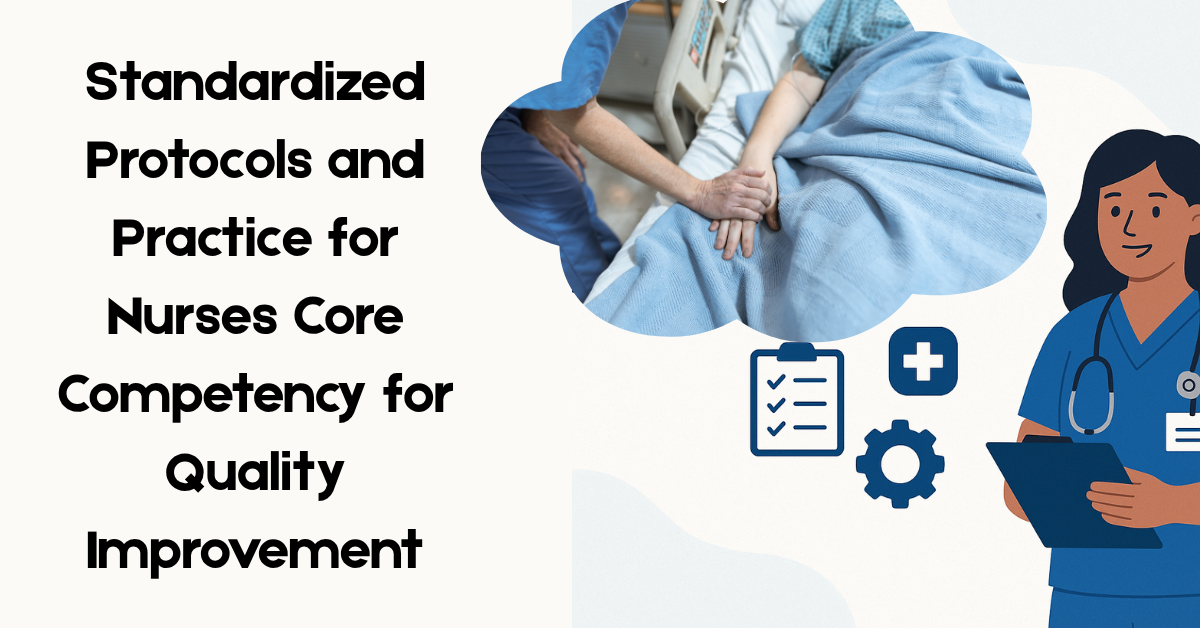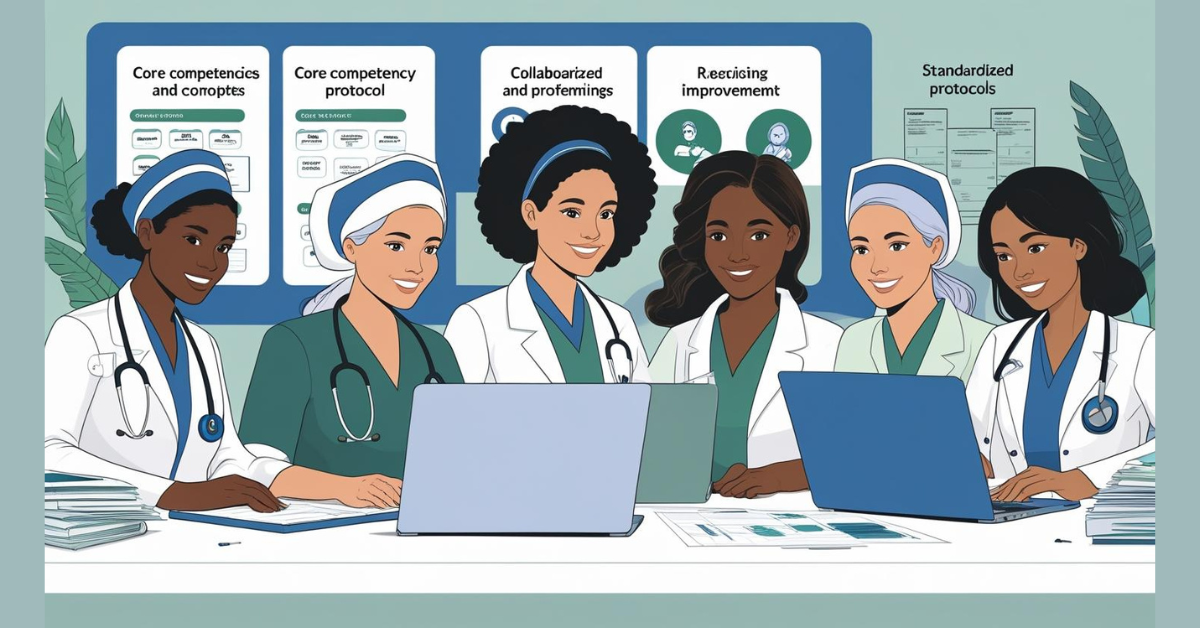The Standardized Protocols and Practice for Nurses Core Competency for Quality Improvement. They must practice independently and assume responsibility for providing safe, compassionate, person-centered, and evidence-based care that respects and upholds human dignity and rights.
The Standardized Protocols and Practice for Nurses Core Competency for Quality Improvement
They must demonstrate professionalism and integrity and work within recognized professional, ethical, and legal frameworks. This paper aimed to clarify the concept of competency in nursing practice and propose a precise definition.
Standardized Protocols and Practice
Standardized protocols can decrease preventable adverse events and medical errors. Common standard protocols are used to prevent mislabeling of radiographs, prevent wrong-site or wrong-patient procedure, and for labeling, packaging, and storing medications (AHRQ, 2005). The AHRQ (2005) identifies the use of evidence based practice and standardized tools as critical aspects of patient safety improvement.
Standardized practice reflects current research findings and best practices and outlines the minimally accepted actions expected from health-care professionals. Standardized practice is linked to several other competencies such as evidence based practice and quality improvement.
Safety Culture
Patient safety and quality care require a culture of safety. The IOM describes a safety culture as one in which “an organization’s care processes and workforce are focused on improving reliability and safety of care for patients” (Kohn, Corrigan, & Donaldson, 2000, p. 114). The goal in a safety culture is to balance accountability with the notion of “no blame” for errors (Wachter & Pronovost, 2009). Transparency is critical in a safety culture. Staff must feel comfortable to report errors, near misses, and potential for errors. Five principles are necessary for the design of a safe health care environment (Kohn, Corrigan, & Donaldson, 2000):
- Providing leadership: Make patient safety a priority objective and everyone’s responsibility. Make sure assignments are clear, with an expectation of safety oversight, and that there are effective mechanisms for identifying and dealing with unsafe practitioners. Provide human and financial resources for error analysis and system redesign.
- Respecting human limits in the design process: Design jobs for safety, and avoid reliance on memory and on vigilance. Simplify and standardize work processes.
- Promoting effective team functioning: Train health-care professionals expected to work in interprofessional teams with others who will be working with them.
- Anticipating the unexpected: Adopt a proactive approach. Identify threats to safety before an accident can occur, and redesign processes to prevent accidents.
- Creating a learning environment: Use simulation whenever feasible. Encourage transparency and reporting of errors without reprisals, and implement mechanisms for feedback and learning from errors. Develop a culture in which communication flows freely.
Creating a safety culture requires nurse leaders and managers to take ownership of patient and worker safety and to foster a work environment in which safety is a top priority. Nurse leaders and managers must understand the complexities of the health-care system and the limits of human factors (Barnsteiner, 2012).
High-Reliability Organizations
High reliability refers to consistent performance at high levels of safety over time (Chassin & Loeb, 2011). The first industries to embrace high-reliability concepts were aviation and nuclear power. High-reliability organizations create processes, systems, and a culture that radically reduce system failures and/or effectively respond when failures do occur (AHRQ, 2008). There are five characteristics fundamental to designing processes and systems for high-reliability organizations (AHRQ, 2008, p. 1):
- Sensitivity to operations: Leaders and staff must be constantly aware of risks to patient safety and focus on preventing them.
- Reluctance to simplify: Avoiding overly simple explanations of failures is essential to understand the true reasons that patient safety is in jeopardy.
- Preoccupation with failure: Leaders and staff must view near misses as evidence that systems should be improved, rather than as proof that the system is working effectively.
- Deference to expertise: Leaders and managers must listen and respond to the insights of frontline staff.
- Resilience: Leaders and staff must be educated and prepared to respond when system failures do occur.
Overall, leaders, managers, and frontline staff must embrace a high-reliability mindset to become a high-reliability organization. High-reliability organizations foster a learning environment and promote a safety culture, evidence-based practice, and a positive work environment for nurses. In addition, they are committed to improving the safety and quality of care.
Current State Of Safety And Quality
There is strong evidence that links nursing practice to patient safety and quality of care (IOM, 2011). Since the publication of the IOM report To Err is Human, there has been a diligent quest to improve the safety and quality of health care. However, some contend that progress has been frustratingly slow (James, 2013; Wachter, 2012). There is some speculation that the IOM’s estimate of 44,000 to 98,000 deaths from prevents able adverse events was an underestimate and that far more lethal errors actually occur each year (Huston, 2014; Wachter, 2012).
In his study, James (2013) contended that health care is experiencing a major epidemic of patient harm. He found that there are, at a minimum, 210,000 lethal preventable adverse events annually. Nurses play a critical role in preventing medication errors, decreasing infection rates, and safe transitions from hospital to home (IOM, 2011). James’s study further substantiates the need to prepare nurses with the necessary knowledge, skills, and attitudes to deliver patient-centered care as members of inter-professional teams, emphasizing evidence based practice, quality improvement, and informatics (Cronenwett, et al., 2007).
Conclusion
Effective nursing leadership and management are critical to providing patients with safe, effective, and quality care. Care must be patient-centered, involving the patient and his or her family in all health-care decisions. In addition, the work environment must foster collaboration and teamwork and must include effective interprofessional and intraprofessional communication. Safe and quality care requires nurses to base their practice on the most current available knowledge.
Nurse leaders and managers must also employ management strategies that are informed by rigorous research to reduce threats to patient safety and to enhance the work environment for staff. Quality of nursing care considers where the care is provided, how the care is provided, and the results or outcomes of the care provided.
Nurses must learn to use technology to systematically identify potential and actual problems and their causes, and they need to develop strategies for prevention and improvement. The ultimate goal of quality improvement is patient and staff safety. Nurses are not expected to be perfect; they are human and will make errors. Nurse leaders and managers must strive for a culture of safety that recognizes the limitations of human factors and takes a proactive approach to prevention of errors.
Read More:
https://nurseseducator.com/didactic-and-dialectic-teaching-rationale-for-team-based-learning/
https://nurseseducator.com/high-fidelity-simulation-use-in-nursing-education/
First NCLEX Exam Center In Pakistan From Lahore (Mall of Lahore) to the Global Nursing
Categories of Journals: W, X, Y and Z Category Journal In Nursing Education
AI in Healthcare Content Creation: A Double-Edged Sword and Scary
Social Links:
https://www.facebook.com/nurseseducator/
https://www.instagram.com/nurseseducator/
https://www.pinterest.com/NursesEducator/
https://www.linkedin.com/in/nurseseducator/
https://www.researchgate.net/profile/Afza-Lal-Din
https://scholar.google.com/citations?hl=en&user=F0XY9vQAAAAJ




Precisely what I was searching for, appreciate it for putting up.
Admiring the persistence you put into your website and detailed information you present. It’s nice to come across a blog every once in a while that isn’t the same unwanted rehashed information. Fantastic read! I’ve bookmarked your site and I’m adding your RSS feeds to my Google account.